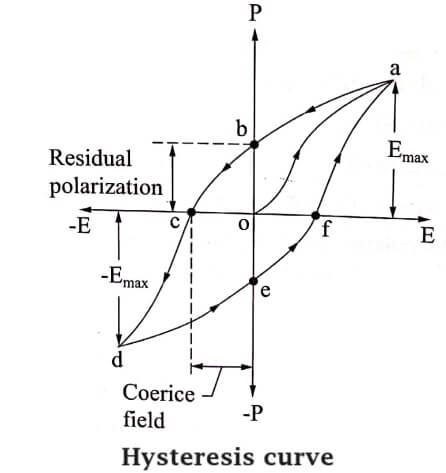Ferro-electricity
When a dielectric material exhibits electric polarization even in the absence of external field, it is known as ferro-electricity and these materials are termed as ferro-electrics.
Ferro-electric
Ferro-electrics are anisotropic crystals which exhibit spontaneous polarization, i.e., they exhibit polarization even in the absence of external electric field.
(iv) Lithium niobate. (v) Lead-zirconate
Properties
- The dielectric constant of these ferro-electric materials is above 2000 and it will not vary with respect to temperature
- The dielectric constant (εr) reaches maximum value only at a particular temperature called curie temperature.
- The polarization does not varies linearly with respect to electric field and hence these materials are also called as non-linear dielectrics.
- Ferro-electrics exhibits electric polarization very easily, even in the absence of external electric field.
- They exhibit domain structure similar to that of a ferromagnetic material.
Hysteresis
When a ferro-electric material is subjected to external electric field (E), the polarization (P) increases with respect to the field applied and it reaches the maximum value, represented by ‘oa’ in Fig.
Now when the external electric field is switched off, then too the polarization in the material will not become zero (curve ‘ab’). This shows that even in the absence of external electric field. The ferro-electric material possess polarization, so called spontaneous (or) residual polarization.
Now to remove this residual polarization, an electric field has to be applied in the opposite direction (-E), represented by the curve ‘oc’, so called coercive field. By further increasing the field from E to Emax, the curve ‘defa’ is obtained which results in a complete polarization hysteresis loop.

This process shows that in a ferro-electric material the polarization does nor vary linearly with respect to the applied electric field.
Applications
- Ferro-electric materials are used to produce ultrasonics.
- They are used in the production of piezo-electric materials and in turn to make microphones.
- Ferro-electrics are also used in SONAR, strain gauges, etc.
- Ferro-electric semiconductors are used to make positors, which in turn are used to measure and control the temperature.
- They are also used as frequency stabilizers and crystal controlled oscillators.
- Electrets are a type of ferro-electric materials, used in the production of capacitor microphones, gas filters, etc.
- Electrets are also used to bond the fractured bones in the human body.
- Phyro-electric materials are also used to produce high sensitive infrared detectors.
| Read More Topics |
| Clausius mossotti equation |
| Temperature dependence of resistance |
| Factors that affect the superconducting property |





